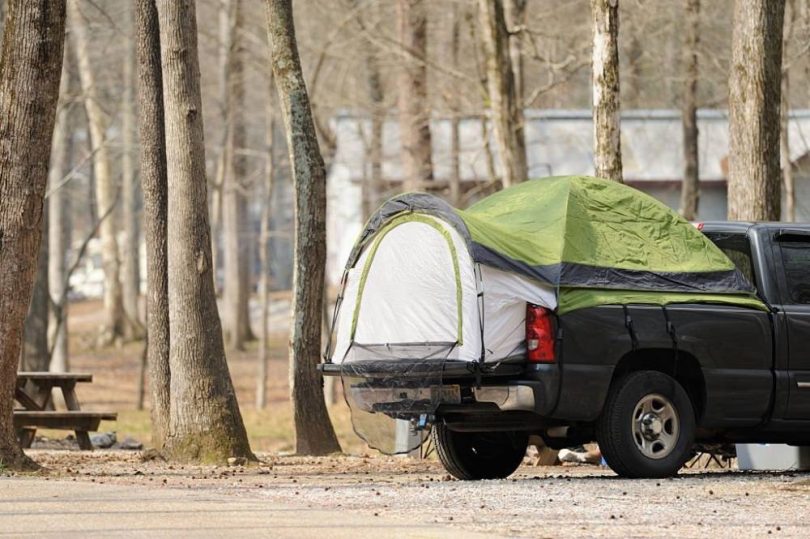What good is a truck if you can’t haul cargo? Making use of your pickup is half the reason you bought it, so spend a few minutes finding out exactly how you can keep that cargo protected from the elements.
There are many ways to keep your truck bed covered up and the cargo dry; from retractable covers to bed shells, some are cheap and fast while others will add real dollar value to your truck.
Keep reading, and we’ll go through the methods, advantages, and disadvantages of the different ways of keeping your cargo dry.
Ways of Keeping Luggage in Your Truck Bed Dry
1. Truck bed shell
If your shell isn’t as easy to install as the Leer shell in the above video, here’s a more general guide to installing a shell.
Step 1
To avoid any damage, lay down a soft material on a flat surface and place your shell upside-down on the material. Shells are heavy, so you’ll need a friend or two to help you out.
Step 2
Apply weather stripping to the bottom of the shell where it will meet the bed rails. Make sure the sticky side of the strip is against the shell.
Step 3
Open the tailgate.
Step 4
Flip the shell up and place it in the truck bed. Walk it towards the front of the truck until you can rest it roughly aligned on the bed rails.
Step 5
Align the cap to the bed rails.
Step 6
Hand-tighten two clamps between the bed rails and the shell at the back of the truck bed. Align the shell and tighten the rest of the clamps in using a ratchet and socket.
Step 7
Close the tailgate
Step 8
Drill a hole small enough to just fit the shell’s wiring near to each light (taillights, top brake light).
Step 9
For each light, remove the light assembly to locate the wire as you poke it through. Connect the shell’s wire to the light assemblies and reinstall them on the shell.
Benefits of a shell
- Enclosed, weather-protected bed
- Mobile camping
- Increased hauling efficiency
- Fuel economy increased by 10% on average
- Aesthetics
Drawbacks of a shell
- Difficult to self-assemble
- Takes up a lot of space when not installed
2. Truck bag
Step 1
You’ll need the bungee cords and bag provided.
Step 2
With bag in the center, attach the cords to each corner of the truck bed (such that the cords are taught). Make sure the zipper faces the tailgate.
Benefits of a truck bag
- Easy to install
- Relatively cheap
- Waterproof
- Weather resistant
- Portable
Drawbacks of truck bags
- May tear
- Good for carrying some things, bad for others
3. Tonneau cover
Step 1
Find the manufacturer’s instructions
Step 2
Place the tonneau on the bed rails as close to the cab as possible
Step 3
Pull down the latches closest to the cab into place under the rail lips.
Step 4
Pull the cover out to the tailgate, open the tailgate, and attach the rearmost latches.
Step 5
Close the tailgate and make sure everything fits.
Benefits of a tonneau cover
- Flush
- Keep the pickup look
- Soft covers can be adjusted for large cargo
- Hard covers are durable
Drawbacks of a tonneau cover
- Soft covers may not last long
- Semi-permanent covers might not accommodate large cargo
4. The classic tarp and bungee method
Step 1
You’ll need a tarp and a set of adjustable bungees
Step 2
Fit the tarp over the cab end of the bed
Step 3
Pull the tarp taught over the bed so that it covers it
Step 4
Hook the adjustable bungees under the body and loop through the holes in the tarp
Step 5
Repeat to the back of the bed until the tarp is secure
Benefits of the tarp and bungee
- Cheap and easy
- Waterproof
- Weather resistant
Drawbacks of the tarp and bungee
- Must be undone and redone every time you get to your cargo
- Possibility of the bungees coming undone in transit
5. The contractor bag
Step 1
You can use many different bags. A bin bag can work as well as thick polyethylene.
Step 2
Place your items in the bag.
Step 3
Place the bag within a second bag for added protection.
Step 4
Secure the bag in the bed. Lots of duct tape or a mesh cover latched to the bed rails.
Benefits of using a contractor bag
- Fast and extremely cheap
- Affords good enough protection
Drawbacks of using a contractor bag
- Not as reliable
- Small cargo space
- One-time solution










Leave a Comment